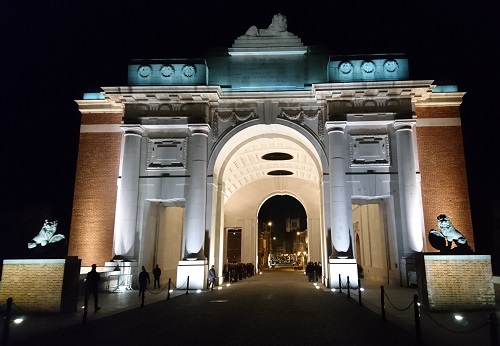
At the end of February, head girl and head boy, Holly Tyrls and Nathan Jones, were accompanied by Head of English and Languages, Mr Butler, on a four-day visit to Belgium and France, as part of a government-funded First World War Centenary Programme.
The award-winning initiative is a key part of the Government’s plan to commemorate the centenary of the First World War by encouraging young people to develop a personal connection to the former battlefields 100 years on.
It gives students the opportunity to interact with a variety of different historic sites, including battlefields, memorials, cemeteries and museums, participate in remembrance ceremonies, and record, reflect and share their own experiences.
The programme allows one teacher and two students from every state school in England to book a free battlefield tour to the Western Front. So, on Sunday 24th February, Holly, Nathan and Mr Butler embarked on their four-day trip of discovery and reflection.
Trip Report by Mr Butler
Day One: Sunday 24th February
After meeting the coach at services on the M6, we voyaged south picking up our companions for the excursion. We spent the first evening in Ashford, Kent, where we became acquainted with the other 14 schools.
The students embarked on some organised team building activities, involving zip wires and climbing walls, while the teachers beavered away at CPD modules well into the evening. The students were then guided through several artefacts from various fields of battle, by three soldiers who would be accompanying us on the trip.
The students then undertook a short research project into two soldiers local to them. Bridgnorth Endowed’s rich history meant that this was something our students were ‘au fait’ with. The school’s tiled memorial tablet and memorial board, both serving as reminders of the students and staff that gave their lives for their country in WW1.
After gathering together for a final debrief, we all had an early night in preparation for our trip under the Channel, early the next morning.
Day Two: Monday 25th February
After a very early breakfast, we departed for Ypres via the ‘Chunnel’. Our first visit took us to Lijssenthoek Cemetery, where we considered the cost of the war and the scale of the casualties. We then proceeded to the Memorial Museum Passchendaele, which included displays, trenches, and an underground tunnel and dugout system.
That evening, we travelled to Ypres to stay in a local hotel and, as they had impressed everyone so much, Holly and Nathan were asked to lead the other students in a discussion about the day. We had a full and frank debate, as we considered the impact of one of the largest commonwealth cemeteries in the world.
We then took part in the Last Post Ceremony at the Menin Gate in Ypres, with Holly being chosen to lay a wreath alongside two members of the Armed Forces. This moving ceremony has been held every evening at 8pm for 100 years, only pausing during the Second World War.
Day Three: Tuesday 26th February
Tuesday was another early start and we headed south to the Somme in France. Here, we visited the Beaumont-Hamel Newfoundland Memorial, a lasting monument to the sacrifice of the Newfoundland soldiers. We explored the preserved trenches and visited the statue of a bronze caribou (a type of reindeer), which is the emblem of the Royal Newfoundland Regiment. After this, we visited Sunken Lane and Caterpillar Valley Cemetery to gain a clear idea of the warfare that ravaged the Somme area of France. We then finished at the Thiepval Memorial, where the 72,338 missing soldiers of the Somme are remembered and inscribed.
Upon returning to the hotel in Ypres, Holly and Nathan led the other students in an in-depth discussion on whether the losses of the Somme were worth it when considering the subsequent victories. Again, they impressed the group with their maturity and ability to work with younger children. After tea, we all gathered together with the soldiers to look closely at how soldiers’ equipment had changed since the First World War.
Day Four: Wednesday 27th February
On Wednesday, we began our long journey home, but not before stopping at Langemark Cemetery. This was the location of over 40,000 German casualties, many of whom were not much older than the students. We then finished our journey with a visit to Tyne Cot Cemetery, the largest of its kind in the world and a moving tribute to the immense sacrifice of World War I.
This trip was emotional and insightful, and Holly and Nathan excelled as older students guiding and leading the younger students in their journey of understanding. They did the school and Bridgnorth proud.



